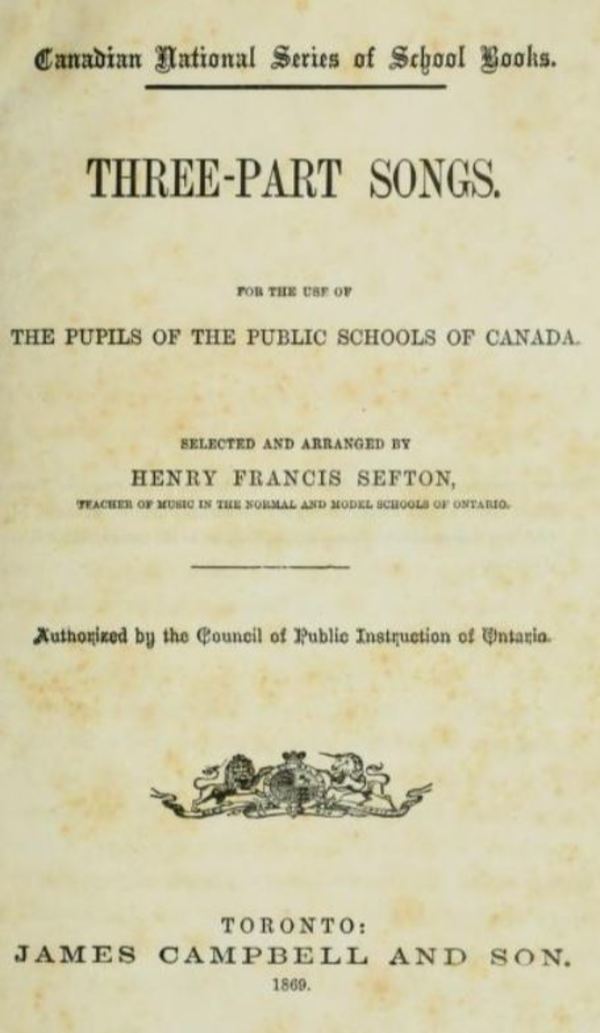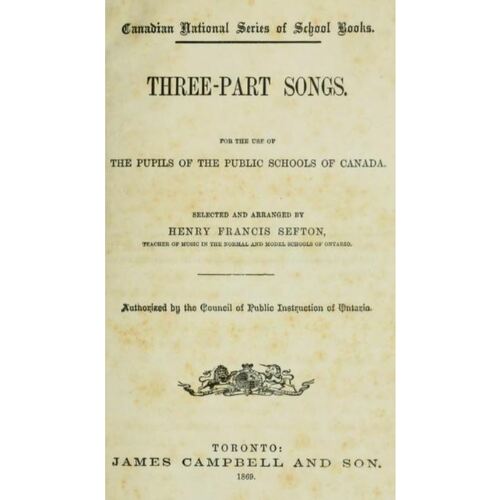
Source: Link
SEFTON, HENRY FRANCIS, music teacher, author, and composer; b. c. 1808 in Worcester, England, son of Henry Sefton and Mary Jones; m. 25 May 1842 Martha Johnston-Brown in Tardebigge, England, and they had eight daughters and one son; d. 21 May 1892 in Toronto at age 84.
A talented singer, composer, and choral director, Henry Francis Sefton was well trained in vocal music. Early in his career he participated in music festivals in Worcester, Gloucester, and Hereford, and at an unknown date he began teaching vocal music in Worcester. In the spring of 1858, at the invitation of Egerton Ryerson*, chief superintendent of education for Upper Canada, Sefton immigrated with his wife and six children to Toronto, where he became music master at the Normal School. According to the terms of his agreement he was to teach eight hours a week at a salary of £80 Halifax currency per five-month session; beginning in 1872 he also taught in the city’s public schools. Interested in the science of music, Sefton had studied in England a fixed-doh method of sight-singing taught by John Pyke Hullah. After teaching Hullah’s method there for 16 years, Sefton had devised an adaptation of it, which he brought to Toronto. By the 1860s, however, he was forced to defend it against a tonic sol-fa method developed in England by John Curwen. Sefton’s response was to write a manual of vocal instruction and to compile a song-book to be used in conjunction with it.
Sefton’s Three-part songs (1869) was the first song-book authorized for use in Ontario’s schools by the Council of Public Instruction [see Henry James Grasett*]. Most of the 131 works were of British origin, but to these he added “a few Canadian compositions, both the words and music being original,” as well as some tunes from “foreign sources.” His preface claimed that “great care has been taken in the selection of the poetry, with a view not only to engaging the interest of the pupils, but also to producing a salutary effect on their principles and habits,” and many of the 21 songs Sefton himself wrote for the book, including “Our country and our queen,” “Employment,” and “The crust of bread,” served patriotic or moral purposes. In A manual of vocal music, likely published shortly after the songbook, Sefton methodically set out his system of instruction, which he claimed to have used “for a number of years in the Normal School of Ontario, with decided success.” The first part of the book, intended for music teachers, explained music theory; the second, for pupils, described the elements of music and included charts and vocal exercises to help them learn its fundamentals. For further practice, Sefton directed both teachers and pupils to appropriate songs in his companion volume, Three-part songs. By the fourth edition of the Manual, printed in 1871, he had added a ten-page supplement, “adapted for the Instruction of Children.”
Although Sefton’s two books met a need created in the late 1860s when the Normal School’s curriculum shifted from academic instruction to pedagogy, his method ultimately proved too difficult for teaching vocal music to school children. Curwen’s system eventually became the authorized form of music instruction in Ontario. Perhaps discouragement at this set-back, or ill health, accounts for a decline in Sefton’s work. Towards the end of his career, students and inspectors began voicing complaints about frequent absences and ineffective teaching. He retired to his Toronto home in 1882, where he lived with his wife and two adult daughters until his death a decade later. A successor at the Normal School, Alexander Thom Cringan*, described him as a “fine theoretical musician.”
Henry Francis Sefton is the author of Three-part songs, for the use of the pupils of the public schools of Canada (Toronto, 1869) and A manual of vocal music, (treated analytically), in two parts; only the fourth edition of the latter work (Toronto, 1871) has been traced. Some of his songs from the former were republished as sheet music by Abraham* and Samuel Nordheimer of Toronto. An arrangement by Sefton of the hymn “Rock of ages” appears in The Canadian musical heritage, ed. Elaine Keillor et al. (9v. to date, Ottawa, 1983– ), 5, no.202.
AO, MU 7451–52, esp. MU 7452, Ryerson to Sefton, 24 April 1858; RG 2, E-1, box 3, folder 2 (1872–75), Sefton to Ryerson, 27 Feb. 1875. Private arch., Margaret [Sefton] Groome (Toronto), Sefton family bible. Ont., Education Dept., Annual report (Toronto), 1883: 151. “The Toronto Normal School; a student’s experiences,” Canada Educational Monthly and School Chronicle (Toronto), 2 (1880): 226–27. Toronto Daily Mail, 23 May 1892. Commemorative biog. record, county York. Encyclopedia of music in Canada (Kallmann et al.). Toronto Normal School, 1847–1947 (Toronto, 1947), 49, 75. G. C. Trowsdale, “A history of public school music in Ontario” (d.ed. thesis, 2v., Univ. of Toronto, 1962), 223, 371, 381. “1858 Ryerson-Sefton letters presented by Sefton family,” Ontario Education News ([Toronto]), 1 (1965), no.1: 2–3.
Cite This Article
Margaret Filshie Leask, “SEFTON, HENRY FRANCIS,” in Dictionary of Canadian Biography, vol. 12, University of Toronto/Université Laval, 2003–, accessed December 31, 2025, https://www.biographi.ca/en/bio/sefton_henry_francis_12E.html.
The citation above shows the format for footnotes and endnotes according to the Chicago manual of style (16th edition). Information to be used in other citation formats:
| Permalink: | https://www.biographi.ca/en/bio/sefton_henry_francis_12E.html |
| Author of Article: | Margaret Filshie Leask |
| Title of Article: | SEFTON, HENRY FRANCIS |
| Publication Name: | Dictionary of Canadian Biography, vol. 12 |
| Publisher: | University of Toronto/Université Laval |
| Year of publication: | 1990 |
| Year of revision: | 1990 |
| Access Date: | December 31, 2025 |



